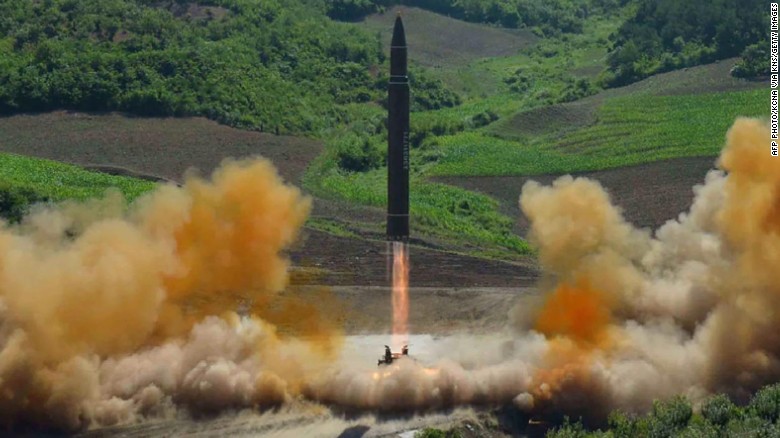The two-stage missile launched Tuesday by North Korea will be classified by US intelligence as a brand-new missile that has not been seen before, US officials told CNN.
The first stage of the missile is believed to be a KN-17 liquid fueled missile, which is well-known to US intelligence and has been previously launched by North Korea.
Ahead of Tuesday’s missile test, US satellites had seen evidence the KN-17 missile was being prepared for launch.
But at some point prior to launch, the North Koreans attached a second stage atop that missile.
The focus now is on the capability of that second stage, and how it technically contributed to making Pyongyang’s latest test its first ever intercontinental ballistic missile (ICBM) launch.
A US defense official said that the latest military assessment suggests the new North Korean missile has a theoretical range of about 5,500 kilometers (3,400 miles), if the missile was shot at a more standard trajectory than Tuesday’s test.
A missile is classified as an ICBM if it can fly a minimum of 5,500 kilometers, which would mean that Pyongyang’s missile is on the line between an intercontinental and intermediate-range ballistic missile (IRBM).
At that range, a North Korean missile could potentially strike Alaska. At the same time, Pyongyang is still several key developments away from actually deploying an ICBM that could carry a nuclear weapon.
CNN has reported that the second stage had a separate 30-second burn cycle, which allowed the missile to travel the extra distance to classify it as an ICBM.
Another defense official says they are still assessing whether the re-entry of the missile was fully controlled. For a missile to successfully strike a target it would have to re-enter the earth’s atmosphere without breaking up.
During a United Nations Security Council meeting Wednesday, US Ambassador to the UN Nikki Haley called Pyongyang’s ICBM missile test a “clear and sharp military escalation.” She said that US military action remained on the table to stop North Korea from threatening the US and its allies.
“The US is prepared to use the full range of our capabilities to defend ourselves and our allies,” Haley said. “One of our capabilities lies with our considerable military forces. We will use them if we must, but we prefer not to have to go in that direction. We have other methods of addressing those who threaten us, and of addressing those who supply the threats.”
Haley called for an “escalated diplomatic and economic response” and said the US would have a new UN resolution in the coming days.
Haley said the US will also “look at any country that chooses to do business with this outlaw regime,” and specifically called out China, noting that 90% of trade with North Korea comes from China.
“Much of the burden of enforcing UN sanctions rests with China,” she said. “We will work with China … but we will not repeat the inadequate approaches of the past that have brought us to this dark day.”
At the Pentagon, spokesman Navy Capt. Jeff Davis, confirmed Wednesday that the missile was “not one we’ve seen before.”
Davis told reporters the ICBM was detected and tracked for 37 minutes, the longest flight time for a North Korean missile. It was launched from Panghyon aircraft plant, about 100 kilometers (62 miles) north of Pyongyang, the first time the North Koreans had used that site for a missile test, he said.
Davis condemned the launch as escalatory and destabilizing, as well as dangerous.
“This missile flew through busy airspace used by commercial airliners,” he said. “It flew into space, it landed in Japan’s exclusive economic zone in an area that is used by commercial and fishing vessels — all of this completely uncoordinated.”
On Monday evening, a US Pacific Command statement initially described the missile as an intermediate range, but further intelligence assessments changed the classification.
“Upon further assessment, it was judged that it was likely capable of going in excess of 5,500 kilometers, which therefore makes it an ICBM,” Davis said.
The imagery showing a KN-17 is in part what led the US to initially believe it was a shorter-range missile.
North Korea announced Tuesday it had successfully tested an ICBM for the first time, which Pyongyang claimed could “reach anywhere in the world.”
North Korean state media said the missile reached an altitude of more than 2,800 kilometers (1,741 miles), before it splashed down in the sea off the Korean Peninsula 930 kilometers (578 miles) from the launch site.
The US and South Korea announced they had conducted a joint exercise in response to the launch, a demonstration that South Korea said was “intended as a strong warning against North Korean provocation.”
